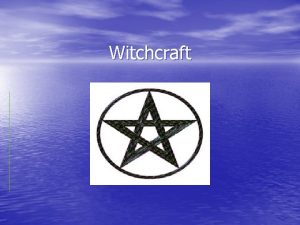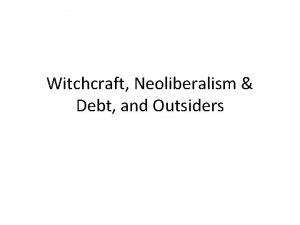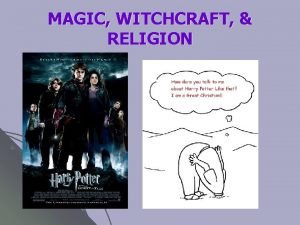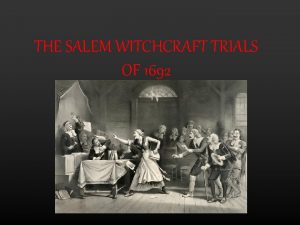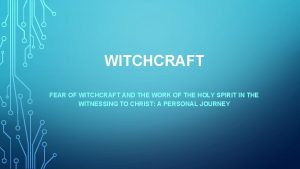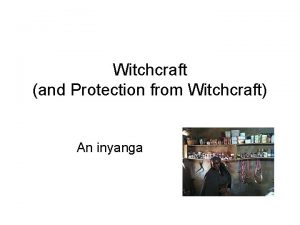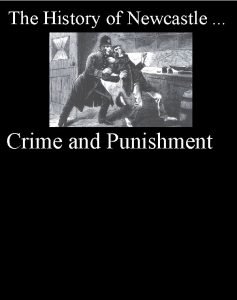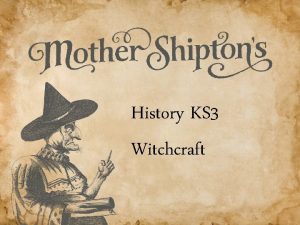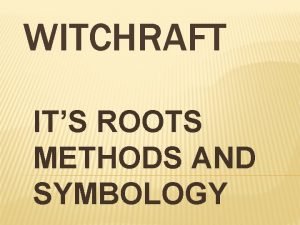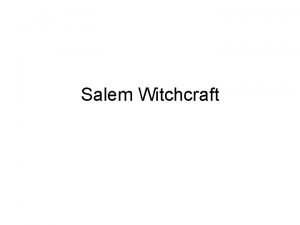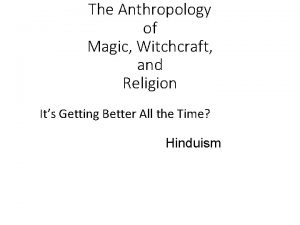The History of Witchcraft What is Witchcraft Witchcraft













- Slides: 13

The History of Witchcraft

What is Witchcraft? • Witchcraft has been around for thousands of years, and it’s gotten a bad reputation due to it’s connection with darkness. Witchcraft broadly means the practice of and belief in magical skills and abilities exercised by the solitary practitioners and groups. This includes spells and the invocation of spirits. • Usually people associate witches with evil and darkness. Witches represented to be the dark side of the female presence. They were described to be old and ugly women who made a pact with the Devil, and they were often feared by society. However, witches haven’t always been viewed this way. Witchcraft has been around since practically the beginning of human civilization. It is a possibility that witches were developed from early goddess cults as women who served the goddess.

• During ancient times in the middle east, the people who practiced the holiest of rituals were women. They could cure babies, dealt with infertility, and they would cleanse houses of evil. These women were referred to as the Wise Women. They were very positive women and were considered to be very important to their society. Without them, they thought no baby would’ve been born without their presence. Scholars consider these women to be the one of the earliest witches in history.

• It has been claimed that women were more commonly to be practicing witchcraft rather than men, but no one really knows where that thought exactly came from. Some believe that accusing women for being witches was a way for the patriarchal institutions to gain dominance over matriarchal ones. • It was believed that it was the church trying to end female healing, which was very common in history, so they can eliminate women with “secret” knowledge. However, there have been men accused of practicing witchcraft, but those allegations weren’t as common.

• They say that it was mainly practiced by old and experienced women. Witches were the mediators between human beings and the mysterious super powers, such as spirits and angels, seeking help or to bring change. • There are many different types of witchcraft, such as shamans, Dianic wicca, Gardnerian Wicca, Pictish witchcraft, ceremonial magic, and much more. https: //www. youtube. com/watch? v=S 64 NLlug. Lv 8

The Social Response to Witchcraft in the 16 th and 17 th Century in Europe. • The majority of the people in Europe during the 16 th and 17 th century were very religious, so witchcraft wasn’t something they accepted, because it was associated with the Devil. To them, being a witch was the worst thing you could be accused and you’d be considered a nightmare of society. • From 1563, when witchcraft and witches became more well known, until 1750, roughly 200, 00 witches were tortured, burnt, and hung, across Western Europe. Witches were handled cruelly and harshly, and usually tortured to gain confession to their craft, along with naming other witches in the village.

• The people conducted witch hunts because they were terrified of witches and their association with the Devil. They’d search for people they labeled as witches or for evidence of witchcraft, often involving moral panic or mass hysteria. • The common belief was that women would make a pact with evil spirits or the Devil and appeal to their intervention. The most common forms of torture used on witches to confess their crimes included “thumb screws” and “leg irons”.

• There were many tests conducted to see if someone was a witch. One test was called the swimming test. According to their logic in the 16 th and 17 th century, if you throw someone in water and they sink, then they are innocent. However, if someone were to rise to the surface then they are a witch. The supposed witch will then be executed. • Also, witches were said not to be able to recite selections from the Bible—usually the Lord’s Prayer, without any mistakes or omissions. This was used as evidence during the witch trials.

Social and Religious Factors Given to the Harsh Response to Witchcraft • During the 16 th and 17 th century, Puritanism became a popular religion and influenced greatly by the church and religious beliefs. Puritan laws were extremely strict, and members of the society were expected to follow them. • Due to this, they believed that whenever they did something wrong, they were required to be punished. Their laws were formed to please God, as they were afraid of God’s wrath and would do anything to avoid it. Therefore, when witchcraft arose, they took it very seriously and the people accused were punished and often sentenced to death.

• The women who strayed away from the Puritan lifestyle were more often accused of witchcraft and were considered to be the outcasts. To the Puritan’s, witches worshiped the Devil and signed a pact with him. They believed that witches were mostly controlled by the Devil, due to their belief that anyone who practiced witchcraft was a sinner, and sinners were easy for the Devil to control.

Modern Witchcraft/Wicca • Witchcraft is something that is still commonly practiced to this day and there are more positive forms of it, rather than negative. • In Africa, there are many different forms of witchcraft. In Southern Africa they have three classifications of someone who uses magic: the first one the “thakathi” and it’s someone who harms others in secret; the “sangoma” who is a shaman that is often employed in predicting someone’s future, practising medicine, and detecting illness; and the “inyanga” who heals injuries and illness through herbalism. The thakathi and sangoma are typically female and the inyanga is usually male.

• Wicca is built around a neo-pagan religion where they worship the earth and nature. It is described to be a positive religion. It is the belief that humans are not superior to nature and that they work more alongside with nature, rather than overruling it. A wiccan does use magic, but not the type of supernatural magic that we hear about or see on TV. It’s more using their five senses and natural elements to produce effective results. Wiccans are also believed to be strong pacifists. To some, Wicca is not considered to witchcraft, because witchcraft is considered to be associated with evil and doesn’t contribute to being good to the earth.

Bibliography https: //www. youtube. com/watch? v=S 64 NLlug. Lv 8 https: //www. binghamton. edu/history/resources/journal-of-history/k-natrella. pdf https: //www. scientificamerican. com/article/why-are-women-accused-of-witchcraft/
 So nguyen to
So nguyen to Tư thế ngồi viết
Tư thế ngồi viết Công thức tính độ biến thiên đông lượng
Công thức tính độ biến thiên đông lượng Tỉ lệ cơ thể trẻ em
Tỉ lệ cơ thể trẻ em đặc điểm cơ thể của người tối cổ
đặc điểm cơ thể của người tối cổ Các châu lục và đại dương trên thế giới
Các châu lục và đại dương trên thế giới độ dài liên kết
độ dài liên kết ưu thế lai là gì
ưu thế lai là gì Thẻ vin
Thẻ vin Kể tên các môn thể thao
Kể tên các môn thể thao Cái miệng bé xinh thế chỉ nói điều hay thôi
Cái miệng bé xinh thế chỉ nói điều hay thôi Hát kết hợp bộ gõ cơ thể
Hát kết hợp bộ gõ cơ thể Từ ngữ thể hiện lòng nhân hậu
Từ ngữ thể hiện lòng nhân hậu Trời xanh đây là của chúng ta thể thơ
Trời xanh đây là của chúng ta thể thơ














